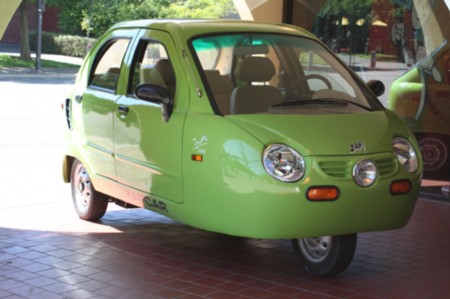







XEBRA TEST DRIVE
Xebra Test drive
by
Noel Adams
On
a recent visit to Santa Rosa I met up with Gary Star at the ZAP corporate
offices and he gave me the opportunity to test drive a Zebra Striped white Xebra.
 First
I took a look at the Xebras in the ZAP showroom.
They had two of the four door sedans and the prototype pickup truck.
I was able to compare the production model sedan with the prototype truck
and the quality differences were very noticeable.
While the Xebraís fit and finish isnít going to make Toyota shake in
their shoes I found that the production vehicles were better than expected for a
Chinese built car, and were as good as most NEVs I have driven.
First
I took a look at the Xebras in the ZAP showroom.
They had two of the four door sedans and the prototype pickup truck.
I was able to compare the production model sedan with the prototype truck
and the quality differences were very noticeable.
While the Xebraís fit and finish isnít going to make Toyota shake in
their shoes I found that the production vehicles were better than expected for a
Chinese built car, and were as good as most NEVs I have driven.
From
the showroom
I
was then passed along to Keith who took me to the car that he is currently using
as a test vehicle. He drove me out
to a quiet location and switched places with me so that I could take a drive.
Surprisingly, for such a small car, there is a lot of room in both the
front and back seat. I had to pull
the front seat forward to get comfortable with the pedals.
The two pedals are set a little farther apart than I am used to and
seemed awkward when I first sat in the drivers seat but when I started to drive
the car I didnít notice any difference from any other car.
Start
up procedure is a little more complex than the average car but not too
dissimilar. Like any automatic you
first step on the brake. Keith explained to me that the car doesnít have much rolling resistance and unlike
more expensive electric vehicles it also doesnít have built in creep when you
take your foot off the brake. The
car will roll backwards if you are facing uphill so you have to be careful.
Next you pull out the big red button located under the driverís seat.
This is the emergency disconnect that servers to isolate the battery
pack. Next, turn the key two clicks
counterclockwise then select the direction you want to go, forward or reverse,
using a switch on the dash. If you
want to go into a reverse there is a further button to push which turns on the
reverse warning beeper and allows you to select reverse.
Finally you release the emergency brake making sure it is all the way
down. Three small red lights below
the voltmeter go off when the brake is fully released.
I
pressed the accelerator gently and the car took off without any noise.
This car isnít going to blow off mustangs when the lights change but
takes off quite nicely, about what you would expect from your average
sub-compact. Driving along it will
easily keep up with city traffic and as speed increases you get that low whine
which is characteristic of most EVs I have driven.
The
car can best be described as minimalist. Keith
explained that it isnít meant for long trips but to be driven on short in-town
hops of fifteen or so minutes. The
seats are quite thin, to allow for more head room, and felt hard, almost like
sitting on a solid bench. The front
seat belts are the normal three point lap and shoulder belts that you would find
in any subcompact car. The Xebra
doesnít have power anything so you have to push quite hard on the brakes to
bring the car to a stop. This feels
a little weird coming from a drive in my Prius, but you adjust quickly and I
never felt nervous about their stopping power.
There didnít appear to be any regenerative braking that I could detect.
There
is also no power steering on the Xebra but the car is pretty light even with the
batteries so steering the car never felt really hard.
I think the single front wheel also helps in that respect.
The car handled pretty well and itís easy to forget that this is a
three wheel car. There was never any
indication of misbehavior during my test drive although I never really had the
opportunity to try and corner hard in the car.
The
indicators on the Xebra are controlled by a stick on the left side of the column
exactly where I expected it to be. They
are also self-canceling which is an improvement on many of the NEVs I have
driven where you have to remember to cancel the signal manually.
The
ride was a little bumpy especially when we crossed some railroad tracks.
It felt like a couple of fillings were jarred loose.
The dashboard had been loosened on this car so that Keith could connect
his multi-meter to measure performance as we moved along and because it was
loose I couldnít really tell if the car would rattle or not but I suspect that
there would be some rattling because of the rough ride.
The
car comes equipped with a heater but no AC.
The
Chinese made charger runs from a standard 110V outlet.
ZAP also offers and optional 220V charger.
When
we returned to the warehouse at the end of my test drive
Conclusion
The
Xebra is obviously not a freeway capable car, it is meant to provide zero
emission transportation for those short commutes and running errands around
town. It is an excellent alternative
to a
The
ride is a bit bumpy but no worse than most of the NEVs I have driven.
The lack of power brakes and power steering may be a problem for some
people but I found that both the stopping power of the disk brakes and the steering
to be quite
acceptable after spending a few moments getting used to them.
If you are concerned a test drive should allow you to determine if this
would be a problem for you.
With
a starting price of just under $10,000 this is a good buy for those looking for
a city class car for a round trip commute of 30 miles or less
![]() About
EVFinder
About
EVFinder ![]() EVents Calendar
EVents Calendar ![]() FAQ
FAQ ![]() EV Selector
EV Selector ![]() Links
Links ![]() The EV Finder Archive
The EV Finder Archive